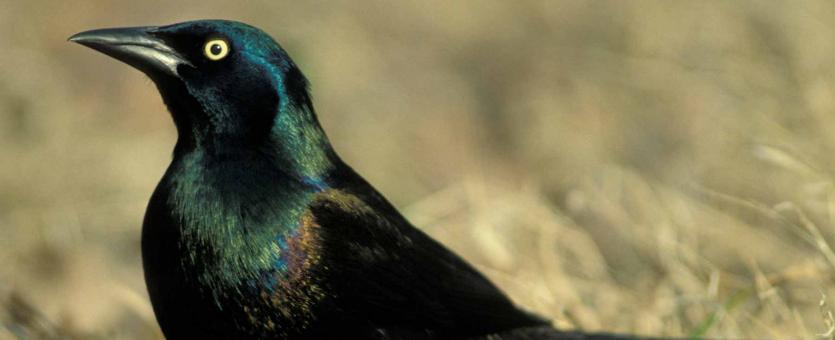
Common grackles are glossy, iridescent blackbirds with elongated bodies and long legs and tail. Adult upperparts are dark bronzy purple, with an iridescent blue-green head and a bright yellow eye. The bill is long and slightly curved. The tail is long and curled upwards on the edges during the breeding season; males often fly with the tail held in a shallow V. Underparts are similar to upperparts. Females are similar, but duller and browner with a short, straight tail. Song is a harsh gurgling squeak: “kree del eeeek.” Call is a harsh “chlack.”
Length: 12½ inches (tip of bill to tip of tail).

Statewide.
Habitat and Conservation
Commonly seen in urban and rural areas, parks, farm lots, pastures, lawns, and lakeshores. Populations are strong continent-wide, though at 73 million birds they are no where near their historic peak of 191 million. Unlike the European starling, which is a nonnative invasive species, the common grackle is native to our continent and is a component of our nation’s natural inheritance.
Food
Common grackles forage on the ground for a variety of seeds, insects, aquatic animals, and even small mammals. Animal foods such as grubs are sought especially during nesting season, for the protein they provide the growing young. Grackles are infamous corn and rice eaters, though they also help farmers by eating insect pests.
Status
Common summer and winter resident; uncommon in northern Missouri during winter.
Life Cycle
The creaky calling, purposeful strutting, and courtship displays of grackles are common signs of spring, in late March and April. Bulky nests are usually built in evergreens or other bushy trees and are constructed of twigs, grasses, and other materials, reinforced with mud. Clutches comprise 1-7 eggs, which hatch in 11-15 days. At first, the young make cheeping sounds, but their demanding voices become louder and creakier as they grow. They fledge in 10-17 days, then follow their parents as they forage on the ground. A grackle might live to be at least 23 years old.
The common grackle is both a summer and winter resident in Missouri, since our state is part of the winter territory for grackles that migrate north to breed in Canada, the Great Plains, and the far-northern United States. Starting in March, watch for noisy flocks of grackles moving through or starting to set up nesting territories, a sure sign of spring!
Human Connections
It is believed that common grackle numbers jumped dramatically as American settlers converted the continent’s forests into cropland; our activities have expanded its habitat. Grackles eat corn in nearly all stages of the crop’s development, and farmers consider them pests.
Ecosystem Connections
When grackles raid another bird’s nest, snap up grasshoppers, pick grubs from the soil, or pluck leeches from a turtle’s leg, they are predators. When they eat berries, they distribute seeds. The native seeds they ate before European settlement used to cover America’s once-vast grasslands.

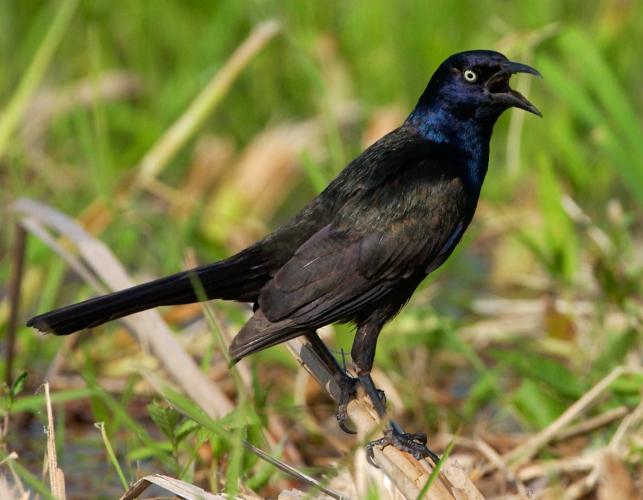
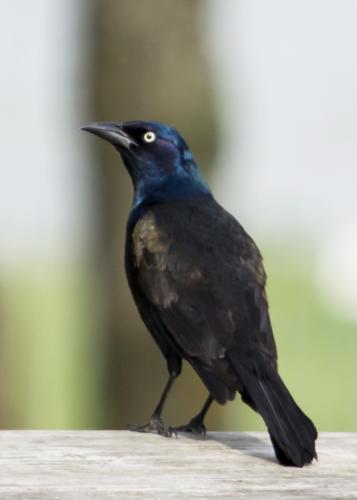

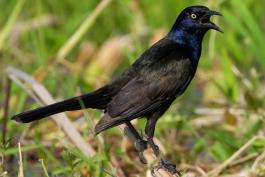
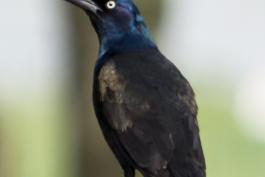
About 350 species of birds are likely to be seen in Missouri, though nearly 400 have been recorded within our borders. Most people know a bird when they see one — it has feathers, wings, and a bill. Birds are warm-blooded, and most species can fly. Many migrate hundreds or thousands of miles. Birds lay hard-shelled eggs (often in a nest), and the parents care for the young. Many communicate with songs and calls.





















